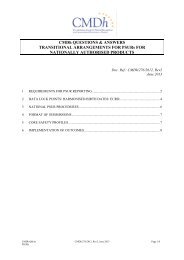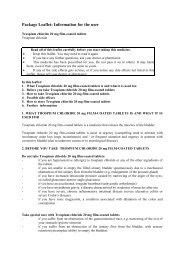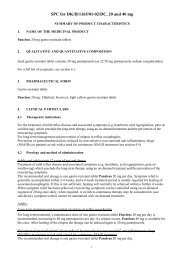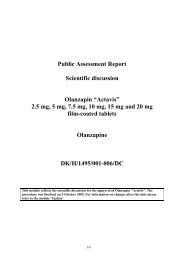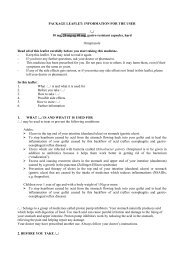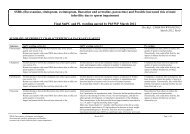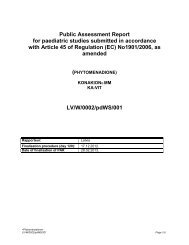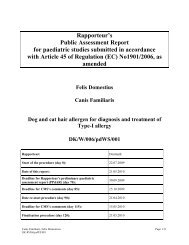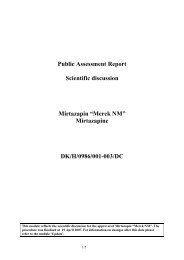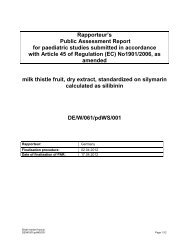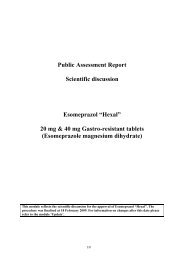CMDh-131-2003-Rev4-Tracked_2012_06.pdf
CMDh-131-2003-Rev4-Tracked_2012_06.pdf
CMDh-131-2003-Rev4-Tracked_2012_06.pdf
Create successful ePaper yourself
Turn your PDF publications into a flip-book with our unique Google optimized e-Paper software.
CORE SPC FOR HORMONE REPLACEMENT THERAPY PRODUCTS<br />
4.1 Therapeutic Indications<br />
Doc. Ref.: <strong>CMDh</strong>/<strong>131</strong>/<strong>2003</strong> Rev 34<br />
December 2009June <strong>2012</strong><br />
<br />
Hormone Replacement Therapy (HRT) for oestrogen deficiency symptoms in postmenopausal<br />
women.<br />
– Sequential HRT regimen: HRT for oestrogen deficiency symptoms [in women at least 6<br />
months since last menses*1];<br />
– Continuous combined HRT regimen: HRT for oestrogen deficiency in women x months<br />
(years) since last menses (depending on the inclusion criteria of the studies submitted in<br />
support of this indication).<br />
<br />
Prevention of osteoporosis in postmenopausal women at high risk of future fractures who are<br />
intolerant of, or contraindicated for, other medicinal products approved for the prevention of<br />
osteoporosis. (See also Section 4.4)<br />
When the target population is wider than the clinical trial population included in the main efficacy<br />
studies, this should be mentioned here. For instance: “The experience treating women older than 65<br />
years is limited.<br />
<br />
When the indication for a HRT product is extended to include perimenopausal women, the studies<br />
must include symptomatic women who have not yet reached menopause but are in the<br />
perimenopausal transitional years, marked by irregularity of menstrual cycles and symptoms of<br />
oestrogen deficiency. Separate analysis of the benefit/risk is recommended, as in perimenopausal<br />
women endogenous oestrogen production has not yet ceased.<br />
Additional indications could be acceptable if they are based on sufficient clinical data.<br />
4.2 Posology and method of administration<br />
The method of administration should be described as briefly as possible.<br />
Oestrogens + progestagens:<br />
<br />
The terminology for dosing of HRT products should be the following:<br />
“Cyclic”: When the oestrogen is dosed cyclically with a treatment-free interval, usually 21 days<br />
on and 7 days off. The progestagen is usually added for 12-14 days of the cycle.<br />
1 *required for all sequential HRT products other than those with sufficient data to demonstrate efficacy and safety in perimenopausal<br />
women<br />
<strong>CMDh</strong>/<strong>131</strong>/2010 Page 1/11
“Continuous sequential”: The oestrogen is dosed continuously. The progestagen is usually added<br />
for 12-14 days (or more) of every 28 day cycle, in a sequential manner.<br />
“Continuous combined”: The oestrogen and the progestagen are given every day without<br />
interruption.<br />
<br />
<br />
<br />
Advice on how to initiate treatment should be given for treatment naive patients and for patients<br />
changing from other HRTs (cyclic, sequential or continuous combined).<br />
When more than one combination of progestagen and oestrogen is available for the same product,<br />
advice should be given on a suitable starting dose combination and criteria given for selecting<br />
another dose combination. Such advice should preferably be based on results of clinical studies.<br />
The section should include the statement:<br />
“For initiation and continuation of treatment of postmenopausal symptoms, the lowest effective<br />
dose for the shortest duration (see also Section 4.4) should be used”.<br />
Oestrogen only:<br />
<br />
<br />
<br />
For oestrogen-only products the indication section should make clear whether the product is<br />
indicated only for women without a uterus. For oestrogen-only products licensed for women with<br />
a uterus, advice on the addition of a progestagen should be given in section 4.2. Only<br />
progestagens approved for addition to oestrogen treatment should be recommended. Generally a<br />
progestagen should be added for at least 12-14 days every month/28 day cycle. Depending on the<br />
range of progestagen doses licensed for addition in the CMS, the advice could give examples of<br />
suitable products and doses.<br />
Unless there is a previous diagnosis of endometriosis, it is not recommended to add a progestagen<br />
in hysterectomised women.<br />
Advice on how to act if a dose is forgotten should be given, including a statement that forgetting a<br />
dose may increase the likelihood of break-through bleeding and spotting.<br />
4.3. Contra-indications<br />
<br />
<br />
<br />
<br />
<br />
<br />
<br />
<br />
<br />
<br />
Known, past or suspected breast cancer;<br />
Known or suspected oestrogen-dependent malignant tumours (e.g endometrial cancer);<br />
Undiagnosed genital bleeding;<br />
Untreated endometrial hyperplasia;<br />
Previous or current venous thromboembolism (deep venous thrombosis, pulmonary embolism);<br />
Known thrombophilic disorders (e.g. protein C, protein S, or antithrombin deficiency, see section<br />
4.4);<br />
Active or recent arterial thromboembolic disease (e.g. angina, myocardial infarction);<br />
Acute liver disease, or a history of liver disease as long as liver function tests have failed to return<br />
to normal;<br />
Known hypersensitivity to the active substances or to any of the excipients;<br />
Porphyria.<br />
4.4 Special warnings and precautions for use<br />
<br />
For the treatment of postmenopausal symptoms, HRT should only be initiated for symptoms that<br />
adversely affect quality of life. In all cases, a careful appraisal of the risks and benefits should be<br />
<strong>CMDh</strong>/<strong>131</strong>/2010 Page 2/11
undertaken at least annually and HRT should only be continued as long as the benefit outweighs<br />
the risk.<br />
<br />
Evidence regarding the risks associated with HRT in the treatment of premature menopause is<br />
limited. Due to the low level of absolute risk in younger women, however, the balance of benefits<br />
and risks for these women may be more favourable than in older women.<br />
Medical examination/follow-up<br />
<br />
Before initiating or reinstituting HRT, a complete personal and family medical history should be<br />
taken. Physical (including pelvic and breast) examination should be guided by this and by the<br />
contraindications and warnings for use. During treatment, periodic check-ups are recommended<br />
of a frequency and nature adapted to the individual woman. Women should be advised what<br />
changes in their breasts should be reported to their doctor or nurse (see ‘Breast cancer’ below).<br />
Investigations, including appropriate imaging tools, e.g. mammography, should be carried out in<br />
accordance with currently accepted screening practices, modified to the clinical needs of the<br />
individual.<br />
Conditions which need supervision<br />
<br />
If any of the following conditions are present, have occurred previously, and/or have been<br />
aggravated during pregnancy or previous hormone treatment, the patient should be closely<br />
supervised. It should be taken into account that these conditions may recur or be aggravated<br />
during treatment with X, in particular:<br />
– Leiomyoma (uterine fibroids) or endometriosis<br />
– Risk factors for thromboembolic disorders (see below)<br />
– Risk factors for oestrogen dependent tumours, e.g. 1st degree heredity for breast<br />
cancer<br />
– Hypertension<br />
– Liver disorders (e.g. liver adenoma)<br />
– Diabetes mellitus with or without vascular involvement<br />
– Cholelithiasis<br />
– Migraine or (severe) headache<br />
– Systemic lupus erythematosus.<br />
– A history of endometrial hyperplasia (see below)<br />
– Epilepsy<br />
– Asthma<br />
– Otosclerosis<br />
Reasons for immediate withdrawal of therapy<br />
Therapy should be discontinued in case a contra-indication is discovered and in the following<br />
situations:<br />
– Jaundice or deterioration in liver function<br />
– Significant increase in blood pressure<br />
– New onset of migraine-type headache<br />
– Pregnancy<br />
Endometrial hyperplasia and carcinoma<br />
<br />
In women with an intact uterus the risk of endometrial hyperplasia and carcinoma is increased<br />
when oestrogens are administered alone for prolonged periods. The reported increase in<br />
endometrial cancer risk among oestrogen-only users varies from 2-to 12-fold greater compared<br />
<strong>CMDh</strong>/<strong>131</strong>/2010 Page 3/11
with non-users, depending on the duration of treatment and oestrogen dose (see section 4.8).<br />
After stopping treatment risk may remain elevated for at least 10 years.<br />
The addition of a progestagen cyclically for at least 12 days per month/28 day cycle or<br />
continuous combined oestrogen-progestagen therapy in non-hysterectomised women prevents<br />
the excess risk associated with oestrogen-only HRT.<br />
Additional warning for oestrogen-only products:<br />
For oral doses of estradiol >2mg, conjugated equine oestrogens >0.625 mg and patches >50<br />
ug/day the endometrial safety of added progestagens has not been demonstrated. (This should be<br />
explicitly stated for such products.)<br />
Break-through bleeding and spotting may occur during the first months of treatment. If breakthrough<br />
bleeding or spotting appears after some time on therapy, or continues after treatment has<br />
been discontinued, the reason should be investigated, which may include endometrial biopsy to<br />
exclude endometrial malignancy.<br />
Additional warning to be included only in the SPC of oestrogen-only products:<br />
“Unopposed oestrogen stimulation may lead to premalignant or malignant transformation in the<br />
residual foci of endometriosis. Therefore, the addition of progestagens to oestrogen replacement<br />
therapy should be considered in women who have undergone hysterectomy because of<br />
endometriosis, if they are known to have residual endometriosis.”<br />
Breast cancer<br />
The overall evidence suggests an increased risk of breast cancer in women taking combined oestrogenprogestagen<br />
and possibly also oestrogen-only HRT, that is dependent on the duration of taking HRT.<br />
Combined oestrogen-progestagen therapy<br />
The randomised placebo-controlled trial the (Women’s Health Initiative study (WHI), and<br />
epidemiological studies are consistent in finding an increased risk of breast cancer in women<br />
taking combined oestrogen-progestagen for HRT that becomes apparent after about 3 years<br />
(see Section 4.8).<br />
Oestrogen-only therapy<br />
The WHI trial found no increase in the risk of breast cancer in hysterectomised women using<br />
oestrogen-only HRT. Observational studies have mostly reported a small increase in risk of<br />
having breast cancer diagnosed that is substantially lower than that found in users of<br />
oestrogen-progestagen combinations (see section 4.8).<br />
The excess risk becomes apparent within a few years of use but returns to baseline within a few (at<br />
most five) years after stopping treatment.<br />
HRT, especially oestrogen-progestagen combined treatment, increases the density of mammographic<br />
images which may adversely affect the radiological detection of breast cancer.<br />
Ovarian cancer<br />
Ovarian cancer is much rarer than breast cancer. Long-term (at least 5-10 years) use of oestrogen-only<br />
HRT products has been associated with a slightly increased risk of ovarian cancer (see section 4.8).<br />
Some studies including the WHI trial suggest that the long-term use of combined HRTs may confer a<br />
similar, or slightly smaller, risk (see Section 4.8).<br />
<strong>CMDh</strong>/<strong>131</strong>/2010 Page 4/11
Venous thromboembolism<br />
<br />
<br />
<br />
<br />
<br />
<br />
HRT is associated with a 1.3-3 fold risk of developing venous thromboembolism (VTE), i.e. deep<br />
vein thrombosis or pulmonary embolism. The occurrence of such an event is more likely in the<br />
first year of HRT than later (see Section 4.8).<br />
Patients with known thrombophilic states have an increased risk of VTE and HRT may add to this<br />
risk. HRT is therefore contraindicated in these patients (see section 4.3).<br />
Generally recognised risk factors for VTE include, use of oestrogens, older age, major surgery,<br />
prolonged immobilisation, obesity (BMI > 30 kg/m 2 ), pregnancy/postpartum period, systemic<br />
lupus erythematosus (SLE), and cancer. There is no consensus about the possible role of varicose<br />
veins in VTE.<br />
As in all postoperative patients, prophylactic measures need be considered to prevent VTE<br />
following surgery. If prolonged immobilisation is to follow elective surgery temporarily stopping<br />
HRT 4 to 6 weeks earlier is recommended. Treatment should not be restarted until the woman is<br />
completely mobilised.<br />
In women with no personal history of VTE but with a first degree relative with a history of<br />
thrombosis at young age, screening may be offered after careful counselling regarding its<br />
limitations (only a proportion of thrombophilic defects are identified by screening).<br />
If a thrombophilic defect is identified which segregates with thrombosis in family members or if<br />
the defect is ‘severe’ (e.g, antithrombin, protein S, or protein C deficiencies or a combination of<br />
defects) HRT is contraindicated.<br />
Women already on chronic anticoagulant treatment require careful consideration of the benefitrisk<br />
of use of HRT.<br />
If VTE develops after initiating therapy, the drug should be discontinued. Patients should be told<br />
to contact their doctors immediately when they are aware of a potential thromboembolic symptom<br />
(e.g. painful swelling of a leg, sudden pain in the chest, dyspnoea).<br />
Coronary artery disease (CAD)<br />
<br />
There is no evidence from randomised controlled trials of protection against myocardial infarction<br />
in women with or without existing CAD who received combined oestrogen-progestagen or<br />
oestrogen-only HRT.<br />
Combined oestrogen-progestagen therapy<br />
The relative risk of CAD during use of combined oestrogen+progestagen HRT is slightly<br />
increased. As the baseline absolute risk of CAD is strongly dependent on age, the number of extra<br />
cases of CAD due to oestrogen+progestagen use is very low in healthy women close to<br />
menopause, but will rise with more advanced age.<br />
Oestrogen-only<br />
Randomised controlled data found no increased risk of CAD in hysterectomised women using<br />
oestrogen-only therapy.<br />
Ischaemic stroke<br />
<br />
Combined oestrogen-progestagen and oestrogen-only therapy are associated with an up to 1.5-fold<br />
increase in risk of ischaemic stroke. The relative risk does not change with age or time since<br />
menopause. However, as the baseline risk of stroke is strongly age-dependent, the overall risk of<br />
stroke in women who use HRT will increase with age (see section 4.8).<br />
<strong>CMDh</strong>/<strong>131</strong>/2010 Page 5/11
Other conditions<br />
<br />
<br />
<br />
<br />
Oestrogens may cause fluid retention, and therefore patients with cardiac or renal dysfunction<br />
should be carefully observed.<br />
Women with pre-existing hypertriglyceridaemia should be followed closely during oestrogen<br />
replacement or hormone replacement therapy, since rare cases of large increases of plasma<br />
triglycerides leading to pancreatitis have been reported with oestrogen therapy in this condition.<br />
Oestrogens increase thyroid binding globulin (TBG), leading to increased circulating total thyroid<br />
hormone, as measured by protein-bound iodine (PBI), T4 levels (by column or by radioimmunoassay)<br />
or T3 levels (by radio-immunoassay). T3 resin uptake is decreased, reflecting the<br />
elevated TBG. Free T4 and free T3 concentrations are unaltered. Other binding proteins may be<br />
elevated in serum, i.e. corticoid binding globulin (CBG), sex-hormone-binding globulin (SHBG)<br />
leading to increased circulating corticosteroids and sex steroids, respectively. Free or biological<br />
active hormone concentrations are unchanged. Other plasma proteins may be increased<br />
(angiotensinogen/renin substrate, alpha-I-antitrypsin, ceruloplasmin).<br />
HRT use does not improve cognitive function. There is some evidence of increased risk of<br />
probable dementia in women who start using continuous combined or oestrogen-only HRT after<br />
the age of 65.<br />
4.5 Interactions<br />
See the SPC guideline.<br />
The following is a model paragraph, which may be modified if interaction studies of the steroids<br />
included in the product indicate differences. The magnitude of effect observed for a specific<br />
product/type of product could be included. For combination products, specific information for the<br />
progestagen should be added.<br />
“The metabolism of oestrogens [and progestagens] may be increased by concomitant use of substances<br />
known to induce drug-metabolising enzymes, specifically cytochrome P450 enzymes, such as<br />
anticonvulsants (e.g. phenobarbital, phenytoin, carbamezapin) and anti-infectives (e.g. rifampicin,<br />
rifabutin, nevirapine, efavirenz).<br />
Ritonavir and nelfinavir, although known as strong inhibitors, by contrast exhibit inducing properties<br />
when used concomitantly with steroid hormones. Herbal preparations containing St John’s wort<br />
(Hypericum Perforatum) may induce the metabolism of oestrogens [and progestagens]. [For<br />
transdermal products the following can be added: At transdermal administration, the first-pass effect<br />
in the liver is avoided and, thus, transdermally applied oestrogens [and progestagens] HRT might be<br />
less affected than oral hormones by enzyme inducers.]<br />
Clinically, an increased metabolism of oestrogens and progestagens may lead to decreased effect and<br />
changes in the uterine bleeding profile.<br />
4.6 Pregnancy and lactation<br />
1. Products with oestrogens only (2 options)<br />
1.1 Indicated for women without uterus<br />
Not applicable, because [Tradename] is only indicated in women without uterus.<br />
1.2 Indicated for women with uterus<br />
[Tradename] is not indicated during pregnancy. If pregnancy occurs during medication with<br />
[Tradename] treatment should be withdrawn immediately.<br />
The results of most epidemiological studies to date relevant to inadvertent foetal exposure to<br />
oestrogens indicate no teratogenic or foetotoxic effects.<br />
<strong>CMDh</strong>/<strong>131</strong>/2010 Page 6/11
2. Products with oestrogens/progestagens (4 options)<br />
2.1 Known progestagen (i.e. human data on exposed pregnancies), no particular effect<br />
[Tradename] is not indicated during pregnancy. If pregnancy occurs during medication with<br />
[Tradename] treatment should be withdrawn immediately.<br />
Clinically, data on a limited/large number of exposed pregnancies indicate no adverse effects of<br />
[progestagen] on the foetus.<br />
The results of most epidemiological studies to date relevant to inadvertent foetal exposure to<br />
combinations of oestrogens + progestagens indicate no teratogenic or foetotoxic effect.<br />
2.2 Known progestagen (i.e. human data on exposed pregnancies), particular effect<br />
[Tradename] is not indicated during pregnancy. If pregnancy occurs during medication with<br />
[Tradename] treatment should be withdrawn immediately.<br />
Data on a limited/large number of exposed pregnancies indicate adverse effects of [progestagen]<br />
on the foetus [to be specified].<br />
The results of most epidemiological studies to date relevant to inadvertent foetal exposure to<br />
combinations of oestrogens + progestagens indicate no teratogenic or foetotoxic effect.<br />
2.3 New progestagen or progestagen without human data; no relevant effects in animal studies<br />
[Tradename] is not indicated during pregnancy. If pregnancy occurs during medication with<br />
[Tradename] treatment should be withdrawn immediately.<br />
For [name of the progestagen] no clinical data on exposed pregnancies are available. Studies in<br />
animals have not shown reproductive toxicity.<br />
The results of most epidemiological studies to date relevant to inadvertent foetal exposure to<br />
combinations of oestrogens with other progestagens indicate no teratogenic or foetotoxic effect.<br />
2.4 New progestagen or progestagen without human data; potentially relevant effects in animal<br />
studies<br />
[Tradename] is not indicated during pregnancy. If pregnancy occurs during medication with<br />
[Tradename] treatment should be withdrawn immediately.<br />
For [name of the progestagen] no clinical data on exposed pregnancies are available. Studies in<br />
animals have shown reproductive toxicity (see 5.3). The potential risk for humans is unknown.<br />
The results of most epidemiological studies to date relevant to inadvertent foetal exposure to<br />
combinations of oestrogens with other progestagens indicate no teratogenic or foetotoxic effect.<br />
Lactation<br />
[Tradename] is not indicated during lactation.<br />
4.8. Undesirable effects<br />
This section should follow the CPMP Note for Guidance on the SPC. Specifically it should contain:<br />
<br />
<br />
An introductory paragraph providing an estimate of the overall percentage of treated patients<br />
expected to experience adverse reactions and a mention of all adverse reactions appearing in ≥10%<br />
of patients in clinical trials.<br />
Following the introductory paragraph, a table should be included, in which all Adverse Drug<br />
Reactions (ADRs) found in clinical trials of the product should be noted. This table should have<br />
the following format:<br />
<strong>CMDh</strong>/<strong>131</strong>/2010 Page 7/11
Organ system class<br />
(e.g. MedDRA<br />
SOC level)<br />
Common ADRs,<br />
>1/100, < 1/10<br />
Uncommon ADRs,<br />
>1/1,000, 1/10,000,<br />
In women with a uterus, use of oestrogen-only HRT is not recommended because it increases the risk<br />
of endometrial cancer (see section 4.4).<br />
Depending on the duration of oestrogen-only use and oestrogen dose, the increase in risk of<br />
endometrial cancer in epidemiology studies varied from between 5 and 55 extra cases diagnosed in<br />
every 1000 women between the ages of 50 and 65.<br />
Adding a progestagen to oestrogen-only therapy for at least 12 days per cycle can prevent this<br />
increased risk. In the Million Women Study the use of five years of combined (sequential or<br />
continuous) HRT did not increase risk of endometrial cancer (RR of 1.0 (0.8-1.2)).<br />
Ovarian cancer<br />
Long-term use of oestrogen-only and combined oestrogen-progestagen HRT has been associated with<br />
a slightly increased risk of ovarian cancer. In the Million Women Study 5 years of HRT resulted in 1<br />
extra case per 2500 users.<br />
Risk of venous thromboembolism<br />
HRT is associated with a 1.3-3-fold increased relative risk of developing venous thromboembolism<br />
(VTE), i.e. deep vein thrombosis or pulmonary embolism. The occurrence of such an event is more<br />
likely in the first year of using HT (see section 4.4). Results of the WHI studies are presented:<br />
WHI Studies - Additional risk of VTE over 5 years’ use<br />
Age range (years) Incidence<br />
per 1000 women in<br />
placebo arm over 5 years<br />
Risk of coronary artery disease<br />
Risk ratio and<br />
95%CI<br />
Oral oestrogen-only*4<br />
50-59 7 1.2 (0.6-2.4) 1 (-3 – 10)<br />
Oral combined oestrogen-progestagen<br />
50-59 4 2.3 (1.2 – 4.3) 5 (1 - 13)<br />
Additional cases per 1000<br />
HRT users<br />
<br />
The risk of coronary artery disease is slightly increased in users of combined oestrogenprogestagen<br />
HRT over the age of 60 (see section 4.4).<br />
Risk of ischaemic stroke<br />
<br />
<br />
The use of oestrogen-only and oestrogen + progestagen therapy is associated with an up to 1.5 fold<br />
increased relative risk of ischaemic stroke. The risk of haemorrhagic stroke is not increased during<br />
use of HRT.<br />
This relative risk is not dependent on age or on duration of use, but as the baseline risk is strongly<br />
age-dependent, the overall risk of stroke in women who use HRT will increase with age, see<br />
section 4.4.<br />
WHI studies combined - Additional risk of ischaemic stroke*5 over 5 years’ use<br />
Incidence<br />
Risk ratio and Additional cases per 1000<br />
Age range (years) per 1000 women in<br />
95%CI<br />
HRT users over 5 years<br />
placebo arm over 5 years<br />
50-59 8 1.3 (1.1 1.6) 3 (1-5)<br />
4 *Study in women with no uterus<br />
5*no differentiation was made between ischaemic and haemorrhagic stroke.<br />
<strong>CMDh</strong>/<strong>131</strong>/2010 Page 9/11
The adverse event table is to be followed by ADRs, (usually class-effects), common to all HRT<br />
products.<br />
Example of a post-tabular text:<br />
Other adverse reactions have been reported in association with oestrogen/progestagen treatment:<br />
– Gall bladder disease.<br />
– Skin and subcutaneous disorders: chloasma, erythema multiforme, erythema nodosum,<br />
vascular purpura.<br />
– Probable dementia over the age of 65 (see section 4.4).<br />
5.1 Pharmacodynamic properties<br />
<br />
Estradiol/Estradiol valerate: The active ingredient, synthetic 17β-estradiol, is chemically and<br />
biologically identical to endogenous human estradiol. It substitutes for the loss of oestrogen<br />
production in menopausal women, and alleviates menopausal symptoms.<br />
Oestrogens prevent bone loss following menopause or ovariectomy. (Note: only for products with<br />
the osteoporosis prevention indication)<br />
or:<br />
Conjugated equine oestrogens: The active ingredients are primarily the sulphate esters of<br />
estrone, equilin sulphates and 17α/β- estradiol. These substitute for the loss of oestrogen<br />
production in menopausal women, and alleviate menopausal symptoms.<br />
Oestrogens prevent bone loss following menopause or ovariectomy. (Note: only for products with<br />
the osteoporosis prevention indication)<br />
<br />
Progestagen:<br />
As oestrogens promote the growth of the endometrium, unopposed oestrogens increase the risk of<br />
endometrial hyperplasia and cancer. The addition of a progestagen greatly reduces the oestrogeninduced<br />
risk of endometrial hyperplasia in non-hysterectomised women.<br />
All other information in this section should be restricted to the indications approved and potential<br />
adverse events (see comment below on lipids).<br />
Clinical trial information<br />
Relief of oestrogen-deficiency symptoms and bleeding patterns<br />
– Relief of menopausal symptoms was achieved during the first few weeks of treatment.<br />
– Regular withdrawal bleeding occurred in x% of women with a mean duration of x days.<br />
Withdrawal bleeding usually started x days before/after the last pill of the progestagen phase.<br />
Break through bleeding and/or spotting appeared in x% of the women during the first three months<br />
of therapy and in x% during months 10-12 of treatment. Amenorrhoea (no bleeding or spotting)<br />
occurred in x% of the cycles during the first year of treatment (for cyclic or sequential products).<br />
or:<br />
– Amenorrhoea was seen in x% of the women during months 10-12 treatment. Irregular bleeding<br />
and/or spotting appeared in x% of the women during the first three months of treatment and in x%<br />
during months 10-12 of treatment (for continuous combined products).<br />
<strong>CMDh</strong>/<strong>131</strong>/2010 Page 10/11
Prevention of osteoporosis<br />
Oestrogen deficiency at menopause is associated with an increasing bone turnover and decline<br />
in bone mass.<br />
The effect of oestrogens on the bone mineral density is dose-dependent. Protection appears to<br />
be effective for as long as treatment is continued. After discontinuation of HRT, bone mass is<br />
lost at a rate similar to that in untreated women.<br />
– Evidence from the WHI trial and meta-analysed trials shows that current use of HRT, alone or<br />
in combination with a progestagen – given to predominantly healthy women – reduces the risk<br />
of hip, vertebral, and other osteoporotic fractures. HRT may also prevent fractures in women<br />
with low bone density and/or established osteoporosis, but the evidence for that is limited.<br />
– After … years of treatment with X, the increase in lumbar spine bone mineral density (BMD)<br />
was x ± x % (mean ± SD). The percentage of women who maintained or gained BMD in<br />
lumbar zone during treatment was x%.<br />
– X also had an effect on hip BMD. The increase after … years was x% ± x% (mean ± SD) at<br />
femoral neck and x ± x% (mean ± SD) at total hip. The percentage of women who maintained<br />
or gained BMD in hip zone during treatment was x%.<br />
Information on biochemical markers of bone resorption and formation should not be included.<br />
BMD is considered a better surrogate endpoint for fracture than biochemical markers.<br />
Information on serum lipids (all products)<br />
Changes in lipids should not be included, as this information is not related to any of the present<br />
indications for HRT. Considering that no benefit has been demonstrated in primary and secondary<br />
prevention of coronary artery disease, the clinical relevance of lipid changes is unknown and the<br />
relevance for the safety of the product therefore highly questionable.<br />
5.2 Pharmacokinetic properties<br />
See the Note for Guidance on the SPC.<br />
For all HRT products, this section should include figures on C max , C average , C min (trough) plasma<br />
levels on the oestrogen and progestagen.<br />
5.3 Preclinical safety data<br />
No specific recommendations. This section should conform to the CPMP Guideline on the Summary<br />
of Product Characteristics. Only results relevant to the prescriber should be mentioned.<br />
When animal studies have indicated embryotoxic or other effects, this observation should be discussed<br />
here, with cross-reference to section.<br />
<strong>CMDh</strong>/<strong>131</strong>/2010 Page 11/11




